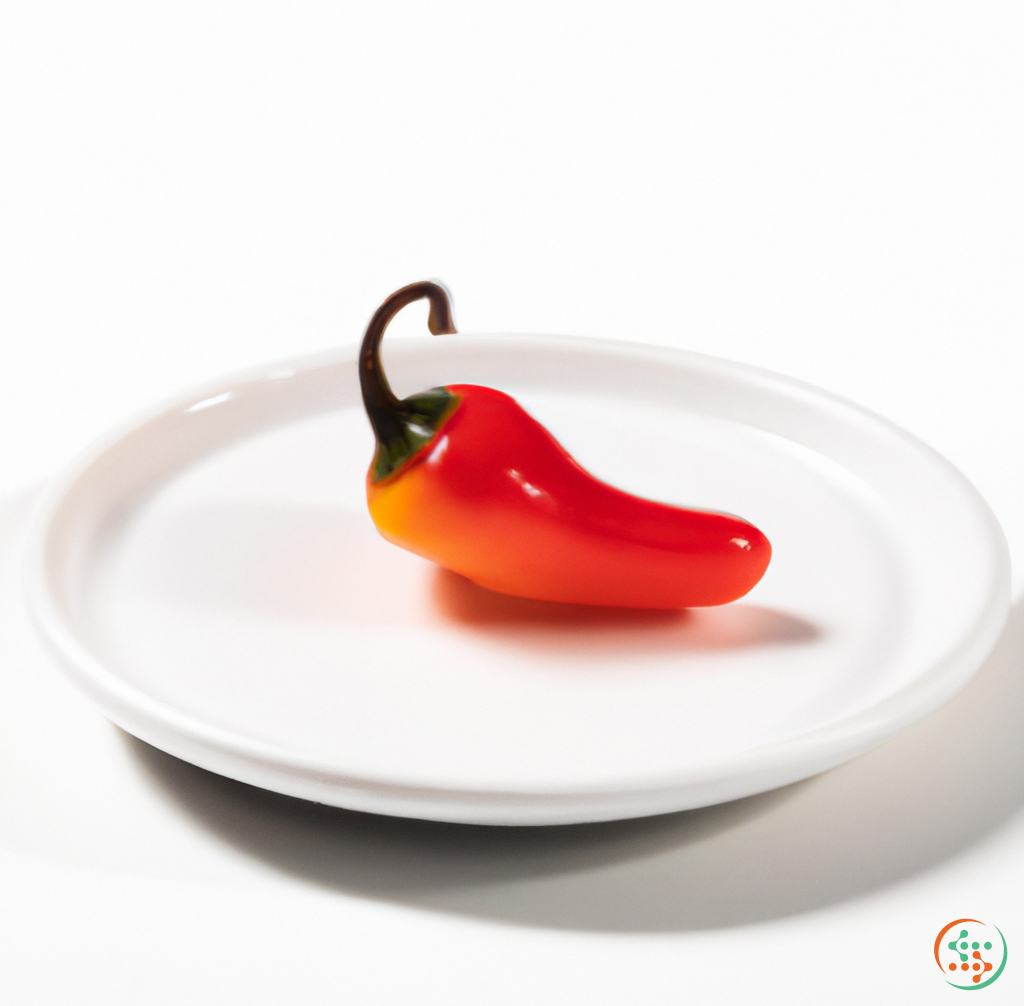Chili Pepper
What is a Chili Pepper?
The chili pepper, also known as a capsicum, is a group of plants in the nightshade family that produces spicy fruits. The fruit of these plants may range in flavor and heat level, from mild to burning hot, depending on the type and variety. They are widely used in many cuisines to add heat and flavor to dishes, and have become a major part of world cuisine, with varying types and amounts used in different places.
Chili peppers can be eaten raw, cooked, or even dried and powdered, to impart their unique flavor and heat. The oils released by chili peppers can affect taste, texture, and even the look of food. Many varieties have been trusted favorites in cultures before the use of spices became popular.
The History of Chili Peppers
Chili peppers originated in South America, and were first domesticated in Mexico from a wild variety more than six thousand years ago. From there, they quickly spread to other parts of the world through the help of travelers and traders.
It is believed that people first began to cultivate chili peppers due to their intense flavor, although its medicinal properties were also appreciated. They were believed to have multiple health benefits and were used as a remedy for a variety of health issues. It is likely that the Aztecs were the first people to cultivate chili peppers, but the use of chili peppers spread quickly throughout the New World and even to Asian countries.
Types of Chili Peppers
There are a wide variety of chili peppers that vary in shape, size, flavor, and heat intensity. Some of the most common types include bell peppers, jalapenos, poblano peppers, habanero peppers, and cayenne peppers.
Bell peppers are the mildest type and are often used as an ingredient in sautés and salads. They have a sweet and crunchy flavor, with a hint of bitterness. Jalapenos are medium-hot chili peppers that have a bright, grassy flavor with a hint of citrus. Poblano peppers are mild-medium heat chili peppers that are typically roasted and stuffed with various ingredients. Habaneros are considered to be the hottest chili peppers, with a citrusy flavor and intense heat. Cayenne peppers are very hot and often used for making hot sauces.
Health Benefits of Chili Peppers
Chili peppers are a powerhouse of nutrition, containing high levels of essential vitamins and minerals. They are also packed with antioxidants and other compounds that may provide a variety of health benefits.
Chili peppers are a good source of vitamin C, which is essential for maintaining a healthy immune system. Vitamin C also helps protect cells from damage and is important for the production of collagen, a major component of your skin.
Chili peppers also contain a compound called capsaicin, which gives them their spicy flavor and is believed to have many health benefits. Capsaicin may help reduce inflammation, lower blood pressure, improve circulation, and even help with weight loss. It is also thought to have anti-cancer effects, although more research needs to be done to fully understand the implications.
Eating chili peppers may also help to reduce the risk of heart disease. Natural compounds in chili peppers have been found to reduce levels of bad cholesterol and increase levels of good cholesterol.
Conclusion
Chili peppers are an important part of many cuisines around the world. They range from sweet and mild to burning hot, and can be used in a variety of dishes to add flavor and heat. Chili peppers are also an excellent source of essential vitamins and minerals, along with powerful antioxidants and other compounds which may provide a range of health benefits.
It may come as a surprise to many, but chili peppers have a surprisingly long and intricate journey from the field to the dinner plate. From the time the pepper is planted to the time it’s eaten, it travels through many processes to become what it is today. In this blog post, we’ll look into the journey of a chili pepper from its origin in the field to its destination on your plate.
The journey of a chili pepper begins in the fields, where it is either grown from seed or from a transplant. The seed-grown chili pepper begins as a seed which is planted in the soil and watered until the seedling germinates. In the case of a transplanted pepper, the pepper is bought from a greenhouse and transplanted into the field. Either way, once the pepper is in the field, it begins its process of getting bigger and bigger by drawing water and nutrients from the soil. While the pepper is growing, it also needs sunlight to help it mature, so it needs to be frequently rotated in the day to ensure all of its sides receive the necessary lighting. As the pepper matures, its color changes from green to its intended hue, like red, yellow, or orange.
Once the chili pepper is fully matured, it is time for farmers to harvest. Farmers must pay extra attention to when harvesting peppers because many of them are delicate, meaning that they can easily crack or break under pressure from being harvested too harshly. Farmers can use handpicking, where they pluck the pepper off the plant, or they can implement mechanical harvesters to help assist the process. Nonetheless, the peppers are then placed in boxes, bins, or cages according to their desired size and weight, and they're ready for transport.
Once the peppers are transported, they generally head to a packinghouse, where they are sorted by size and color. In some cases, the packaging may be left up to the farm, but in most cases, the peppers are sent to a packinghouse, where they are graded, checked for quality, and packaged. The peppers are packed with cushioning material to prevent them from getting damaged or spoiled during transport. The package is then loaded onto a box truck and shipped to the supermarket, grocery store, or farmer’s market, depending on where the farmer is selling their peppers.
Once the peppers make it to the grocery store or farmer’s market, they are generally stored in the produce section alongside other fresh fruits and vegetables. Consumers can choose to buy the peppers fresh and intact or purchase them in bulk, depending on what they need. The peppers then move to the home of the consumer, where they will either be consumed fresh or prepared and cooked in a variety of dishes.
When preparing chili peppers, the consumer must first consider which variety of pepper they want to use. This may mean considering the level of heat they desire. Once the consumer has selected their pepper of choice, they must begin the process of preparing it. Generally, this means washing off and cutting away the stem, seeds, and ribs of the pepper before chopping or slicing the flesh. Once the peppers have been cut, they can be added to a recipe or eaten raw.
As you can see, chili peppers have a long and complex journey from their initial planting to appearing on your dinner plate. From the seedling to the dinner plate, chili peppers have to go through many different processes and stages in order to end up on your plate as a tasty dish. It’s an incredible journey that you sometimes overlook, but knowing its complexity can make you appreciate that next chili pepper a little bit more.
| Vitamin A | 0.001324 grams | |
| Beta-Carotene | 0.014844 grams | |
| Alpha-Carotene | 0.994 mg | |
| Vitamin E | 0.00314 grams | |
| Vitamin K | 0.1082 mg | |
| Vitamin C | 0.0314 grams | |
| Vitamin B1 | 0.08 mg | |
| Vitamin B2 | 0.00121 grams | |
| Vitamin B3 | 0.00867 grams | |
| Vitamin B4 | 0.0843 grams | |
| Vitamin B5 | 0.96 mg | |
| Vitamin B6 | 0.81 mg | |
| Vitamin B9 | 0.051 mg |
| Calcium | 0.045 grams |
Daily Value 1.3 g
|
| Iron | 0.00604 grams |
Daily Value 0.018 g
|
| Magnesium | 0.088 grams |
Daily Value 0.4 g
|
| Phosphorus | 0.159 grams |
Daily Value 1.25 g
|
| Potassium | 1.87 grams |
Daily Value 4.7 g
|
| Sodium | 0.091 grams |
Daily Value 2.3 g
|
| Zinc | 0.00102 grams |
Daily Value 0.011 g
|
| Copper | 0.23 mg |
Daily Value 0.9 mg
|
| Manganese | 0.82 mg |
Daily Value 0.0023 g
|
| Selenium | 0.0035 mg |
Daily Value 0.055 mg
|
| Tryptophan | 0.135 grams | |
| Threonine | 0.389 grams | |
| Isoleucine | 0.342 grams | |
| Leucine | 0.554 grams | |
| Lysine | 0.471 grams | |
| Methionine | 0.127 grams | |
| Cystine | 0.203 grams | |
| Phenylalanine | 0.327 grams | |
| Tyrosine | 0.22 grams | |
| Valine | 0.447 grams | |
| Arginine | 0.508 grams | |
| Histidine | 0.215 grams | |
| Alanine | 0.433 grams | |
| Aspartic Acid | 1.512 grams | |
| Glutamic Acid | 1.397 grams | |
| Glycine | 0.391 grams | |
| Proline | 0.46 grams | |
| Serine | 0.425 grams |
| Total Sugars | 41.1 grams |
per 100g
|
| Myristic acid (14:0) | 0.02 grams |
|
| Palmitic acid (16:0) | 0.69 grams |
|
| Stearic acid (18:0) | 0.11 grams |
|
| Total Saturated fatty acids: | 0.82 g | |
| Oleic acid (18:1) | 0.45 grams |
|
| Palmitoleic acid (16:1) | 0.02 grams |
|
| Total Monounsaturated fatty acids: | 0.47 g | |
| Linolenic acid (18:3) | 0.02 grams |
|
| Linoleic acid (18:2) | 3.06 grams |
|
| Total Polyunsaturated fatty acids: | 3.08 g | |







